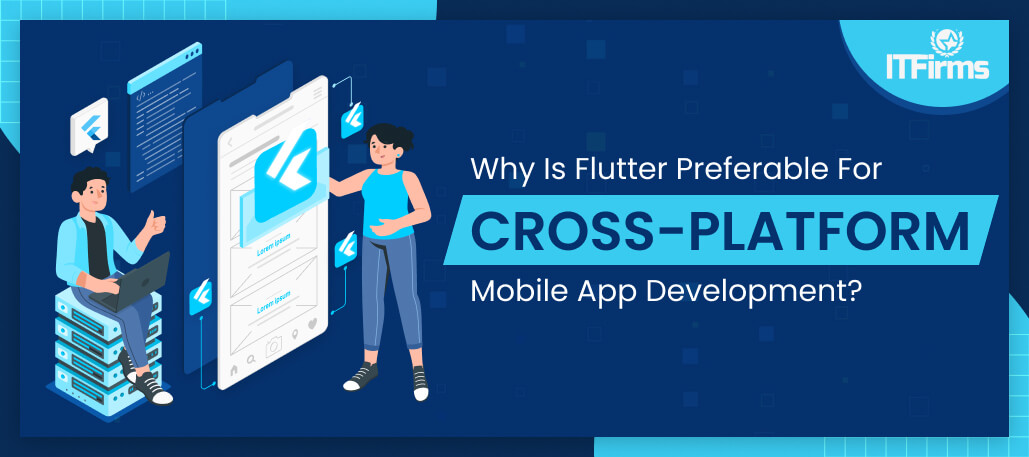
Why is Flutter preferable for Cross-Platform Mobile App Development?
“2022 Update – This is a check on Flutter for Hybrid Applications!”
With Flutter, hybrid developers only need to scribble their code once. This single code works around one platform but can be tweaked a bit to make applications across another platform work.
How does Flutter work?
Flutter is based on a foundation library, widgets, and Flutter engine. It makes use of declarative UI authoring and utilizes a collection of widgets to design the complete user interface. Flutter provides multiple software packages and enables access to Firebase and Redux data warehouses to improve the user experience.
More Applications and Benefits of Flutter
Flutter Secure Storage package uses Keystore for Android and Keychains for iOS, both of which are considered standard in terms of securing sensitive data to your users’ mobile devices.
Flutter with Firebase helps applications maintain different users and authenticate them. To accomplish this, developers create a Firebase account, add a project with the desired project name, and follow the SDK instructions provided by Firebase to connect the Flutter Project with Firebase.
Flutter is relatively easy to install, and use. It comes with easily customizable, and established user interface components to choose from, a shorter turnaround time for screen development, is functional, is aesthetic, and has a short developer run cycle.
Google Analytics SDK – Flutter Fire acts as an inbuilt app measurement solution to log events, set user properties, debug events, track screen views, measure eCommerce, measure ad revenue, extend with cloud functions, error codes, reference API, configure data collection and usage
Flutter Secure Storage package uses Keystore for Android and Keychains for iOS to secure sensitive data to your users’ mobile devices.
Google Flutter Team releases frequent security fixes and patches to secure the apps. Flutter SDK plugins and packages are the safest ways to secure the flutter app.
Rename obfuscation hides vulnerable strings, methods, class names and API keys to form compiled binaries, that look much less complicated.
DART programming language handles platform-specific obfuscation for native code.
The Proguard configuration file obfuscates the code and shrinks the size of Android Apps.
In the iOS app, the compiler strips the symbols and applies optimizations to the code, making it difficult for attacks.
Restricted API access to API keys secures it from potential attacks. Application restriction controls which websites, IP addresses, or applications can use your API key. You can set one application restriction per key (None, HTTP referrers (web sites), IP addresses (web servers, cron jobs, etc.), Android apps, iOS Apps). Besides server-side restrictions, Flutter apps can be secured by moving the integrations to the backend and exposing the methods via RESTful APIs.
Also encrypting and decrypting API keys on runtime adds an extra layer of protection.
API keys of Flutter open source projects should not be tracked on the repository. Instead, enforce the use of environment configuration files.
Firebase Remote Config should not be used to store sensitive data as you make changes without publishing the build.
A whistling domain is a trusted way to restrict network traffic/congestion to an unsecured endpoint. Other ways to safeguard Flutter apps from hackers are certificate pinning, restricting dubious permission requests, caching integrating local authentication, securing developer identity, securing CI infrastructure, and enforcing strict access control (good to have).
What does Flutter offer?
- It can be optimized to create minimum viable products for mobile devices.
- It offers high-level widgets and an adaptable user interface.
- It provides plugins for advanced operating systems with simple logic.
- To build layouts
- To add interactivity
- To add animations
- To internationalize the Flutter app
Conclusion: What do we learn?
Cross-platform app development companies use Flutter to build beautiful user interfaces. It speeds up the app development process and reduces project costs as the same code can be used on multiple platforms.
Big brands like Airbnb, Uber, Alibaba, Baidu, Betterment, Bytedance, GooglePay, CrowdSource, Groupon, Kotak, iRobot, Philips Hue, Realtor.com, Hamilton, and Square are using Flutter for cross-platform app development in e-commerce, retail, banks, FinTech, large businesses, and enterprises.
Flutter applications are less complex and act as a productive prototyping tool. It speeds feature development and synchronizes release schedules across the entire customer base. Flutter delivers branded designs, and supports a variety of hardware (camera, GPS, storage, network) and services (payments, cloud storage, ads, and authentication).
